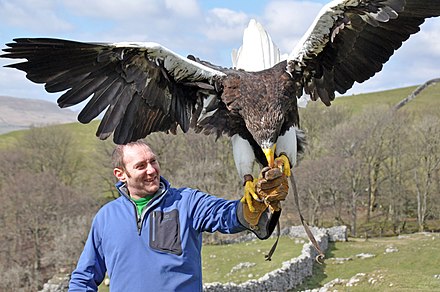Steller’s Sea Eagles are the largest among eagles, with an adult bird’s wingspan reaching up to 2.5 meters and a weight of up to 9 kg. These majestic birds are native to the spawning rivers of the Magadan Region, the coastal zone of the Sea of Okhotsk, Kamchatka, Sakhalin, and the island of Hokkaido. While some individuals overwinter near their nesting grounds, others migrate to Japan, Sakhalin, Primorye, or even as far as the Western Hemisphere.
The Average Distance Steller’s Sea Eagles Travel From Their Nest
According to the available data, Steller’s Sea Eagles have been observed to travel up to 12 km from their nests using a radio-range. However, specific information on their average or maximum distances traveled is not readily available.
The nests of Steller’s Sea Eagles are typically built with large sticks along the Sea of Okhotsk. Migrating birds sometimes loop the sea, moving to the southern part of the Kamchatka peninsula, wintering on the Japanese island of Hokkaido, or heading south to the Koreas. While these birds are known to wander more widely as juveniles and sub-adults, it is still rare to see them in the eastern United States.
Factors Influencing the Distance Traveled by Steller’s Sea Eagles
 Image source: stellers sea eagle
Image source: stellers sea eagle
Several factors can influence the distance Steller’s Sea Eagles travel from their nests:
-
Food Availability: These eagles are primarily fish-eaters, so the availability of their prey in the surrounding areas can determine how far they need to travel to find food.
-
Breeding and Nesting Needs: During the breeding season, Steller’s Sea Eagles may need to travel further to gather nesting materials or find suitable breeding sites.
-
Migratory Patterns: As mentioned earlier, some Steller’s Sea Eagles migrate to different regions, which can involve longer distances from their nesting grounds.
-
Age and Experience: Younger, less experienced Steller’s Sea Eagles may wander more widely, while older birds may have established more defined foraging and nesting territories.
-
Environmental Conditions: Factors such as weather, habitat changes, and human disturbance can also affect the distances these eagles travel from their nests.
Unique Characteristics of Steller’s Sea Eagles
Steller’s Sea Eagles are known for their impressive size and distinctive appearance. Some key facts about these birds:
- Wingspan: Up to 2.5 meters
- Weight: Up to 9 kg
- Plumage: Dark brown body with white shoulders, tail, and wing patches
- Beak: Large, hooked, and yellow in color
- Habitat: Coastal areas, rivers, and sea coasts near the Sea of Okhotsk
These eagles are also known for their hunting prowess, often preying on fish, waterfowl, and small mammals. They are skilled at soaring and diving to catch their prey.
Conservation Status and Threats
Steller’s Sea Eagles are classified as “Vulnerable” on the IUCN Red List of Threatened Species. Their population is estimated to be around 5,000-8,000 individuals, with the majority found in Russia.
Some of the main threats to Steller’s Sea Eagles include:
- Habitat Loss: Deforestation and development along coastal areas can reduce the availability of suitable nesting and foraging sites.
- Poaching and Illegal Hunting: These birds are sometimes targeted for their feathers or as trophies.
- Environmental Pollution: Oil spills, chemical contamination, and other forms of pollution can harm the eagles and their prey.
- Climate Change: Changing weather patterns and environmental conditions can disrupt the eagles’ breeding and feeding habits.
Conservation efforts, such as habitat protection, anti-poaching measures, and public education, are crucial to ensuring the long-term survival of Steller’s Sea Eagles.
Conclusion
Steller’s Sea Eagles are remarkable birds that have captured the imagination of birdwatchers and nature enthusiasts around the world. While specific data on the average or maximum distances they travel from their nests is limited, it is clear that these eagles are capable of covering significant distances in search of food, breeding sites, and suitable wintering grounds. Understanding the factors that influence their movements and the threats they face is essential for their conservation and protection.
References:
– Wikipedia – Steller’s Sea Eagle
– Steemit – About Steller’s Sea Eagles and a Radio Range with a Range of 12 km
– Raptor Resource – About That Steller’s Sea Eagle
– San Diego Zoo – Steller’s Sea Eagle
– National Geographic – Steller’s Eagle

